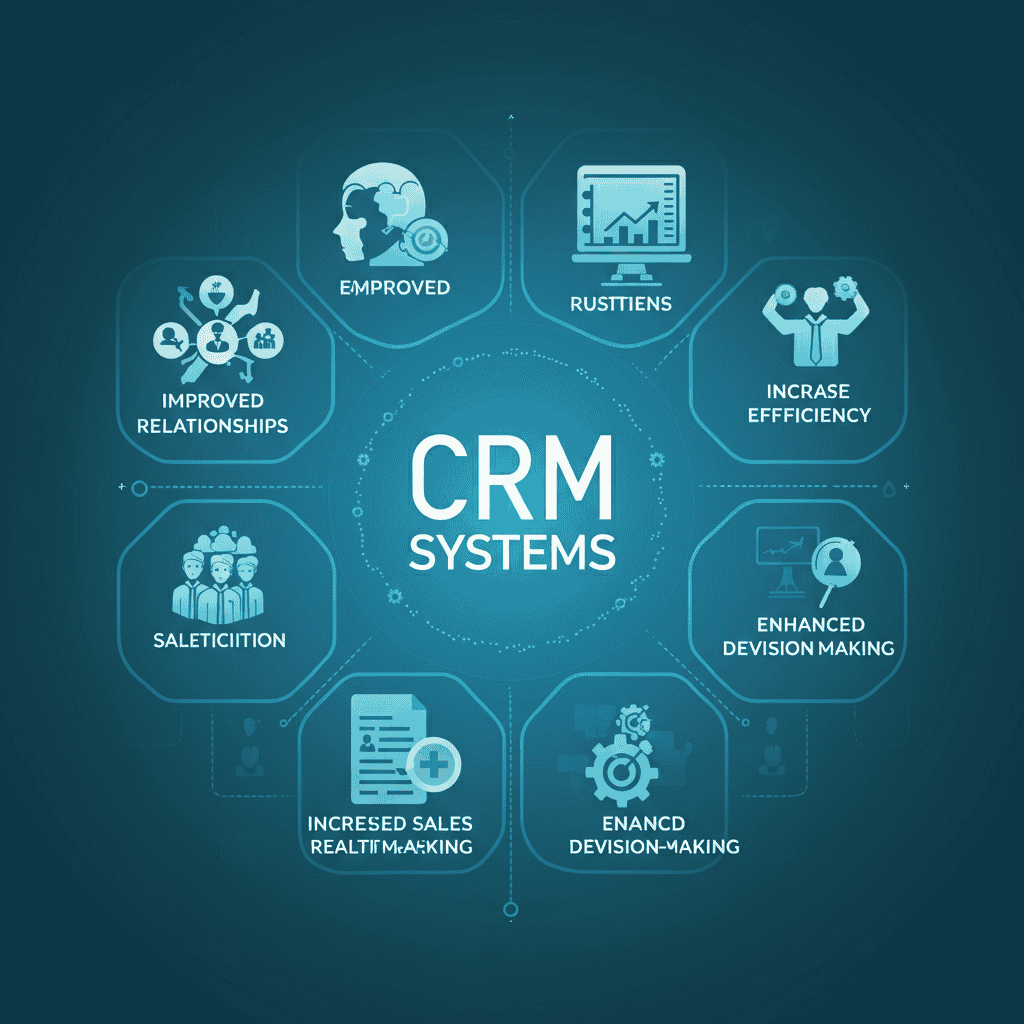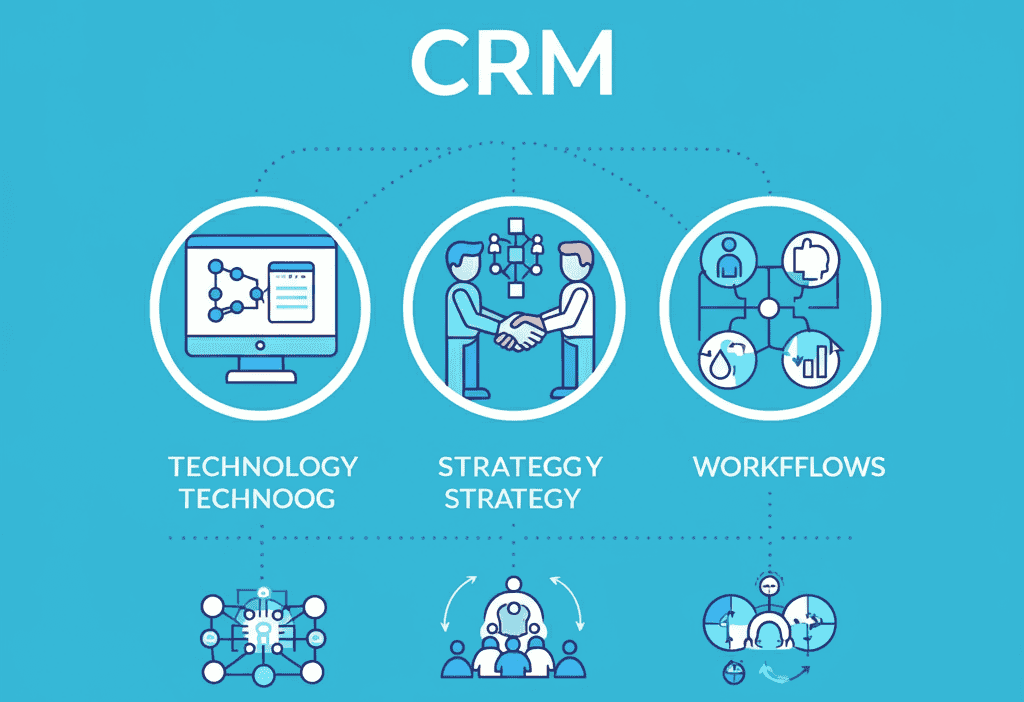Every business owner knows the frustration: a potential customer walks away because they felt ignored, or a loyal client switches to a competitor after a poor service experience. These moments highlight a fundamental truth about modern business—success hinges not just on what you sell, but how you manage relationships with the people who buy from you.
Customer Relationship Management (CRM) has evolved from a simple contact database into a comprehensive strategy that can make or break your business. Companies using CRM systems see an average ROI of $8.71 for every dollar spent, yet many businesses still struggle to implement effective CRM practices.
This guide will walk you through everything you need to know about CRM, from basic concepts to advanced strategies that can transform how you connect with customers and grow your business.
Understanding Customer Relationship Management
Customer Relationship Management refers to the practices, strategies, and technologies companies use to manage and analyze customer interactions throughout the customer lifecycle. The goal is simple: improve customer relationships, retain existing customers, and drive sales growth.
At its core, CRM combines three essential elements:
Technology: Software platforms that store customer data, track interactions, and automate processes.
Strategy: The approach your business takes to build and maintain customer relationships.
Process: The specific workflows and procedures your team follows when interacting with customers.
Modern CRM goes beyond just storing contact information. It provides a complete view of each customer’s journey, from their first website visit to their most recent purchase, enabling personalized experiences that build loyalty and drive revenue.
Types of CRM Systems
Understanding the 4 types of Customer Relationship Management systems helps you choose the right solution for your business needs. Each type serves a unique purpose in managing customer interactions and optimizing business operations:
-
Operational CRM
Operational CRM focuses on automating and improving customer-facing processes. This type streamlines three key areas:-
Sales automation manages lead tracking, opportunity management, and sales forecasting. Your sales team can see exactly where each prospect stands in the pipeline and what actions to take next.
-
Marketing automation handles email campaigns, social media marketing, and lead nurturing. The system can automatically send personalized messages based on customer behavior and preferences.
-
Service automation manages customer support tickets, service requests, and issue resolution. Support teams can quickly access customer history and provide faster, more informed assistance.
-
-
Analytical CRM
Analytical CRM transforms customer data into actionable insights. It examines patterns in customer behavior, identifies trends, and predicts future actions. This type helps answer critical questions like:-
Which customers are most likely to make repeat purchases?
-
What products should you recommend to specific customer segments?
-
When are customers most likely to cancel their subscriptions?
-
-
Collaborative CRM
Collaborative CRM breaks down silos between departments, ensuring everyone has access to the same customer information. Sales, marketing, and customer service teams can work together more effectively when they share a unified view of each customer relationship. -
Strategic CRM (optional addition if you’d like to round out the “4 types”)
Strategic CRM is focused on long-term customer engagement. It uses insights from customer data to drive business decisions and align products and services with customer needs. This approach ensures that CRM is not just operational but also deeply embedded in company’s strategy.
Key Features of Modern CRM Systems
Today’s CRM platforms offer powerful features that automate routine tasks and provide deeper customer insights.
Contact and Lead Management
CRM systems serve as a centralized database for all customer information. Beyond basic contact details, modern systems track communication history, purchase behavior, preferences, and interaction patterns across multiple channels.
Lead scoring capabilities help prioritize prospects based on their likelihood to convert, while automated lead routing ensures inquiries reach the right team members quickly.
Sales Pipeline Management
Visual pipeline management shows exactly where each opportunity stands in your sales process. Sales managers can identify bottlenecks, forecast revenue more accurately, and coach team members on specific deals.
Advanced systems provide AI-powered insights that suggest the best next actions for each opportunity and predict which deals are most likely to close.
Marketing Automation
Integrated marketing tools enable personalized campaigns based on customer data and behavior. You can create automated email sequences, segment customers for targeted messaging, and track campaign performance across multiple channels.
Many systems also include social media management features, allowing you to monitor brand mentions and engage with customers on their preferred platforms.
Customer Service Tools
Built-in help desk functionality manages support tickets, tracks resolution times, and maintains knowledge bases. Customer service representatives can see the complete interaction history, enabling them to provide more personalized and efficient support.
Self-service portals empower customers to find answers independently, reducing support volume while improving customer satisfaction.
Analytics and Reporting
Comprehensive reporting capabilities track key metrics across sales, marketing, and customer service. Customizable dashboards provide real-time visibility into performance, while advanced analytics identify trends and opportunities for improvement.
Integration with business intelligence tools enables deeper analysis and more sophisticated forecasting capabilities.
Benefits of Implementing CRM

The advantages of effective CRM implementation extend far beyond simple contact management.
Improved Customer Relationships
CRM systems enable personalized interactions by providing complete customer context. When every team member can see a customer’s history, preferences, and past issues, they can provide more relevant and helpful service.
This personalization leads to stronger relationships, increased customer satisfaction, and higher retention rates.
Increased Sales Efficiency
Sales teams become more productive when CRM automates routine tasks like data entry, follow-up reminders, and report generation. Representatives can focus more time on building relationships and closing deals.
Pipeline visibility helps sales managers identify coaching opportunities and remove obstacles that might prevent deals from closing.
Enhanced Customer Retention
CRM systems help identify at-risk customers before they leave. By tracking engagement levels, support tickets, and usage patterns, businesses can proactively address issues and improve retention rates.
Automated customer success programs can trigger outreach campaigns when customers reach specific milestones or show signs of decreased engagement.
Data-Driven Decision Making
Comprehensive analytics provide insights that drive better business decisions. You can identify which marketing campaigns generate the highest-quality leads, which products have the best profit margins, and which customer segments offer the greatest growth potential.
This data-driven approach reduces guesswork and helps allocate resources more effectively.
Choosing the Right CRM Solution
Selecting the appropriate CRM system requires careful consideration of your business needs, budget, and growth plans.
Assess Your Requirements
Start by evaluating your current processes and identifying pain points. Consider factors like:
- Team size and growth projections
- Integration needs with existing tools
- Industry-specific requirements
- Budget constraints
- Technical expertise of your team
Consider Deployment Options
Cloud-based CRM solutions offer lower upfront costs, automatic updates, and easier scalability. On-premise solutions provide greater control and customization but require more IT resources.
Most small to medium-sized businesses benefit from cloud-based solutions due to their flexibility and lower total cost of ownership.
Evaluate Integration Capabilities
Your CRM should integrate seamlessly with existing tools like email platforms, accounting software, and marketing automation systems. Poor integration creates data silos and reduces system effectiveness.
Plan for User Adoption
The most sophisticated CRM system fails if your team doesn’t use it consistently. Look for solutions with intuitive interfaces and strong training resources. Consider involving end-users in the selection process to improve buy-in.
CRM Implementation Best Practices
Successful CRM implementation requires careful planning and change management.
Define Clear Objectives
Establish specific, measurable goals for your CRM implementation. Whether you want to increase sales by 20%, improve customer retention by 15%, or reduce response times by 50%, clear objectives guide decision-making and measure success.
Start with Clean Data
Data quality directly impacts CRM effectiveness. Before migrating information, clean existing databases by removing duplicates, updating outdated information, and standardizing data formats.
Provide Comprehensive Training
Invest in thorough user training that goes beyond basic system navigation. Help team members understand how CRM supports their specific roles and contributes to overall business success.
Monitor and Optimize
CRM implementation is an ongoing process, not a one-time project. Regularly review system usage, gather user feedback, and make adjustments to improve effectiveness.
Track key performance indicators to measure ROI and identify areas for improvement.
Common CRM Challenges and Solutions
Understanding potential obstacles helps you prepare for and overcome implementation challenges.
Low User Adoption
Many CRM implementations fail because employees resist using the new system. Combat this by involving users in the selection process, providing adequate training, and demonstrating clear benefits.
Make CRM usage part of performance evaluations and recognize employees who effectively utilize the system.
Data Quality Issues
Poor data quality undermines CRM effectiveness. Establish data entry standards, implement validation rules, and regularly audit information quality.
Consider using data enrichment tools that automatically update contact information and company details.
Integration Difficulties
Disconnected systems create inefficiencies and data silos. Prioritize integration planning during system selection and allocate adequate resources for connecting your CRM to other business tools.
Your Path to CRM Success
Customer Relationship Management represents more than just a software purchase—it’s a commitment to putting customers at the center of your business strategy. The companies that thrive recognize that every interaction shapes customer perception and influences future buying decisions.
Success with CRM requires the right technology, clear processes, and organizational commitment to continuous improvement. Start by assessing your current customer management practices, defining specific objectives, and choosing a solution that aligns with your business needs and growth plans.
Remember that CRM implementation is a journey, not a destination. As your business evolves and customer expectations change, your CRM strategy should adapt accordingly. The investment in time and resources will pay dividends through stronger customer relationships, improved efficiency, and sustainable business growth.
Learn more: How to Manage Your Business Online Reputation





